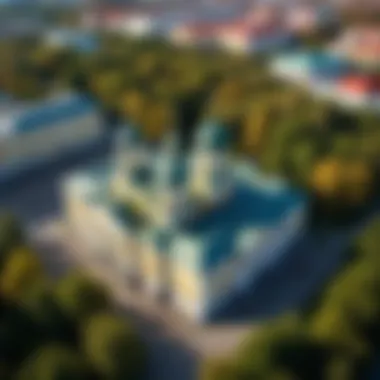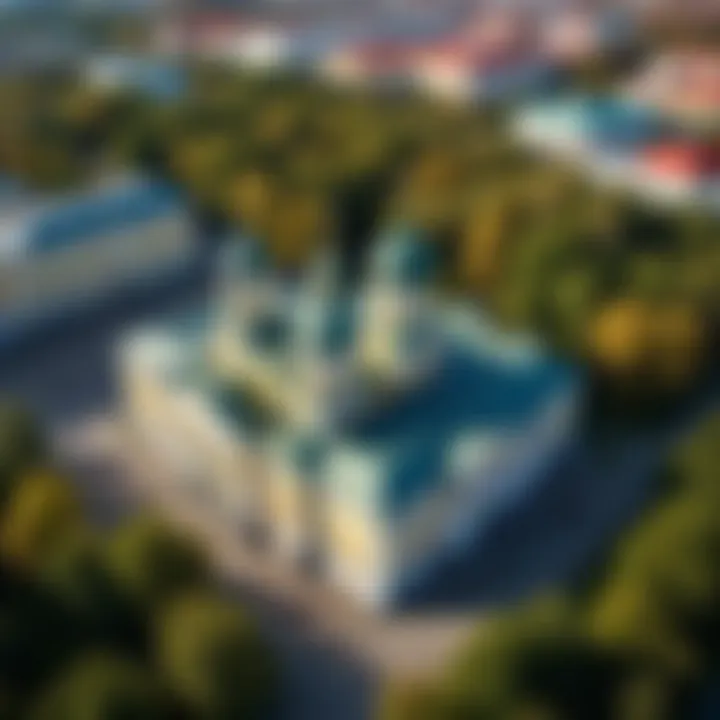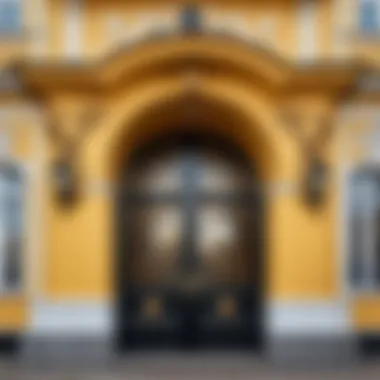Discovering Alexander Nevsky Lavra: A Cultural Landmark


Intro
Alexander Nevsky Lavra is not just a religious site; it is a monumental chapter in the narrative of Russian history. Located in St. Petersburg, this monastery holds the final resting places of many individuals who shaped the cultural and political landscape of Russia. The Lavra has transcended its role as a sanctuary for monks, becoming a repository of the country’s rich heritage.
The historical significance of Alexander Nevsky Lavra is deeply intertwined with the very identity of St. Petersburg. From its founding in 1710, it has served as a spiritual center, and also as a burial ground for prominent figures. This article will explore the Lavra, its notable inhabitants, and the cultural legacy they have left behind.
Understanding the stories of those interred within the Lavra provides insight into the broader strokes of Russian history. From writers to military leaders, each figure represents a facet of the national narrative. As we delve deeper into this sacred space, we will uncover the manner in which these lives and legacies continue to resonate in contemporary culture and society.
By the end of this journey through Alexander Nevsky Lavra, readers will gain a comprehensive understanding of the site’s cultural context and its role within the mosaic of Russian heritage. This exploration is not just about the physical location, but the lives that enrich its soil and the stories that echo through its walls.
Next, we will examine the popular attractions in and around the Lavra, providing insights into why it stands as a must-visit destination for travelers gazing for a deeper understanding of Russia's past.
Prolusion to Alexander Nevsky Lavra
Alexander Nevsky Lavra stands as one of the most significant religious and cultural landmarks in St. Petersburg. Its history is interwoven with the stories of many notable figures, making it a crucial site for understanding Russian heritage. This section emphasizes the relevance of the Lavra both as a burial site and a monument that encapsulates centuries of history and artistry.
Historical Background
Founded in 1710 by Peter the Great, the Alexander Nevsky Lavra was built to commemorate the victory over Sweden at the Battle of Neva. The monastery has served different roles throughout its existence. Initially, it was intended as a spiritual sanctuary but slowly evolved into a burial place for distinguished Russians. Many prominent personalities have found their final resting place here, illustrating the unique blend of spirituality and historical significance.
The Lavra's historical landscape reflects the shifting political and cultural tides of Russia. The site grew in prominence especially during the 19th century when it became associated with the Russian Orthodox Church. This transition attracted not just clergy but also influential figures in literature, politics, and arts, who wished to be laid to rest in this hallowed ground.
Architectural Significance
The architectural style of Alexander Nevsky Lavra is a testament to the Baroque period, characterized by its intricate designs and grandiose structures. The masterpiece of the Lavra is undoubtedly the Cathedral of the Holy Trinity, which boasts a remarkable dome and stunning frescoes that capture the viewer's imagination. Designed by the architect Domenico Trezzini, the cathedral is exemplary of early Russian Baroque architecture.
The monastery complex itself is vast, containing numerous chapels, bell towers, and tombs that showcase different architectural styles over the years. The blend of styles reflects the influences of various cultural movements across time. Visitors to the Lavra can appreciate the artistry and craftsmanship that went into constructing these buildings, which serve both functional and aesthetic purposes.
Cultural Importance
Culturally, Alexander Nevsky Lavra acts as a symbol of Russian resilience and pride. It has been a site for pilgrimage for many generations. The Lavra plays an essential role in Russian literature and art, inspiring writers like Fyodor Dostoevsky and artists like Ivan Aivazovsky. Their works often allude to the themes of mortality, sanctity, and the legacies of the personalities buried within its grounds.
Moreover, the Lavra hosts various cultural events that promote traditional music and art, reinforcing its role as a living institution within St. Petersburg. It continues to be a focal point for those who seek to connect with the rich history and culture of Russia.
"The Lavra protects a wealth of memory, where the past echoes softly in its halls."
In summary, the historical, architectural, and cultural significance of Alexander Nevsky Lavra provides a comprehensive frame to appreciate its enduring legacy. Tourist and scholars alike benefit from exploring this monumental site, gaining insights into the interconnectedness of faith, art, and history in St. Petersburg.
Notable Figures Buried at Alexander Nevsky Lavra


The Alexander Nevsky Lavra, a remarkable historical and religious site, serves as the final resting place for many influential figures in Russian history. This section aims to provide insights into the notable personalities interred here, highlighting their contributions to culture, politics, military, and religion. The significance of these figures reflects the cultural heritage of Russia and the enduring legacy of those who shaped its history.
Overview of Interred Personalities
The Lavra houses a diverse group of individuals, whose lives and work have left an indelible mark on Russian society. From writers to military leaders, these personalities represent a spectrum of Russian history. Their graves are not merely markers of death; they symbolize the values, struggles, and triumphs of their time.
Visitors to the Lavra can explore the resting places of these figures, gaining insight into their achievements and the historical context in which they lived. The journey through the Lavra provides a tangible connection to the past. It encourages reflection on the broader narrative of Russian identity and culture.
Prominent Cultural Figures
Among the notable interred at the Lavra are cultural icons such as Alexander Pushkin and Fyodor Dostoevsky. Pushkin, often hailed as the father of Russian literature, revolutionized poetry and prose in the 19th century. His works delve into themes of love, struggle, and philosophical inquiry. Dostoevsky, his contemporary, explored the human condition through psychological depth in novels like "Crime and Punishment".
These writers not only shaped literature but also influenced various art forms, fostering a greater understanding of the human experience. Their graves draw admirers, scholars, and fans alike, who wish to pay homage to their literary genius.
Politicians and Statesmen
The Lavra also honors important political figures such as Mikhail Kutuzov, a celebrated general known for his leadership during the War of 1812. His strategic acumen contributed to the Russian victory against Napoleon's army.
These leaders reflect the political tension and complexities of their era. Their contributions often extend beyond military victories, involving pivotal decisions that shaped the course of Russian history. The presence of such figures at the Lavra underscores its role as not just a spiritual site, but also a monument to national pride and resilience.
Military Leaders at Rest
In addition to politicians, military leaders are among those interred at the Lavra. Their sacrifices and leadership during tumultuous times resonate through history. Figures like General Nikolai Raevsky exemplify the bravery and tactical skill displayed in key battles.
These leaders are honored not only for their military prowess but for their dedication to the service of their country. The Lavra serves as a solemn reminder of their contributions, inspiring visitors with stories of courage and honor.
Religious Leaders and Their Legacy
The significance of the Alexander Nevsky Lavra extends into the realm of religion. Several influential religious leaders are interred within its hallowed grounds. This includes figures like Saint Alexander Nevsky himself, who is venerated for his piety and service to the Russian Orthodox Church.
These leaders contributed to the religious and spiritual development of the Russian people. Their legacies are reflected in the values and beliefs upheld by the church. Visitors learn about the theological and cultural impact of these leaders, illustrating the intertwined nature of faith and national identity in Russia.
"The Alexander Nevsky Lavra is not just a cemetery; it is a testament to the culture and resilience of the Russian people."
In summary, the notable figures buried at Alexander Nevsky Lavra enrich the site's historical narrative. Their stories of cultural impact, political strife, military valor, and spiritual guidance offer a multifaceted view of Russia's past, inviting deep reflection and understanding.
The Impact of Alexander Nevsky Lavra on Russian Culture
Alexander Nevsky Lavra holds significant cultural weight in Russia. This monastery is not just a resting place for notable figures; it embodies the intersection of faith, history, art, and literature. Its influence stretches beyond religious boundaries and resonates through various aspects of Russian life. Understanding this impact is essential for grasping the broader narrative of Russian cultural evolution.


Influence on Literature and Arts
The presence of Alexander Nevsky Lavra has permeated Russian literature and art significantly. Numerous authors and poets have drawn inspiration from both the site and the figures buried within. For instance, Fedor Dostoevsky often referenced spiritual themes found in such sacred places, paralleling the existential struggles of his characters with the history of the Lavra itself. In addition, artwork from famous painters, like Ilya Repin, often mirrors the visuals and themes related to this holy site, echoing its sentiments and reflection of moral dilemmas.
Moreover, the Lavra’s architecture serves as a muse for various artists, who sought to capture its beauty and historical significance. Visiting the site offers a glimpse into the past, allowing artists to creatively express their interpretations and emotions. This has led to a vibrant dialogue between past and present within Russian cultural narratives.
Memorialization of Historical Figures
The Lavra is also a crucial site for the memorialization of numerous historical figures. Each interred personality, ranging from military leaders to cultural icons, tells a story that contributes to the collective Russian identity. These figures are not simply names on gravestones; they are pillars of past glories and tragedies, reflecting societal values, struggles, and triumphs during their respective eras.
Visitors often find connection to these figures through organized tours and educational materials provided by the Lavra. This makes the site a living museum, bridging history with the current generation. Memorial events and commemorative readings contribute to this continuity, enhancing the respect and reverence held by the public for their contributions. Through this careful preservation of memory, Alexander Nevsky Lavra serves as a reminder of the individuals who shaped Russia’s cultural landscape.
"The Lavra stands as a testament to the intertwining of faith, history, and culture that characterizes the Russian experience."
The lasting impact of Alexander Nevsky Lavra on Russian culture cannot be understated. It is a treasure trove of stories, inspiration, and identity that continues to resonate, illustrating how history shapes culture and how cultural sites enrich our understanding of the past.
Visiting Alexander Nevsky Lavra
Visiting Alexander Nevsky Lavra is more than a mere exploration of a religious site. It is a profound encounter with a significant part of Russian history and culture. The Lavra serves as a bridge connecting visitors to the past. The layers of history embedded in its grounds tell stories of those buried here and their contributions to society. This journey is essential for understanding not just the Lavra itself, but also the broader cultural context of St. Petersburg.
Understanding the site's accessibility and what visitors can expect enhances the experience. It allows travelers to properly plan their visit and make the most of their time at this remarkable location.
Site Details and Accessibility
Alexander Nevsky Lavra is situated in St. Petersburg, easily accessible by public transport. Many visitors opt for the metro, as the nearby stations are merely a short walk away. Surrounding the Lavra, the urban landscape provides a glimpse of the vibrant life of the city.
The entrance to the Lavra is marked, making it easy to find. Opening hours are usually consistent throughout the week, allowing for flexibility in scheduling. However, during religious holidays or events, it may be wise to check in advance, as access could be limited or adjusted.
Facilities are provided for tourists. These include guided tours, informative signage, and resting areas, ensuring a comfortable visit. Some areas of the Lavra may require modest attire, reflecting its sacred nature. This indicates respect for the cultural and religious significance of the site.
Visitor Experience
The visitor experience at Alexander Nevsky Lavra is multifaceted. Upon entering, one is greeted by the tranquility of the grounds, a stark contrast to the bustling city outside. The architecture alone stirs a sense of awe. Each building narrates its own part of history, showcasing Baroque and neoclassical elements that reflect eras of change and continuity.
An essential aspect of the experience is the ability to walk among the tombstones in the Necropolis. Here, one can linger at the graves of notable figures, reflecting on their lives and legacies. Many visitors find this moment to be particularly moving. The serene atmosphere encourages contemplation and an appreciation for the contributions each individual made to Russian history.
Guided tours are available. These provide deeper insights into the Lavra's significance and its famed interred personalities. Knowledgeable guides shed light on lesser-known facts and anecdotes, transforming a simple visit into a rich learning experience.
In addition, photographic opportunities abound. While being respectful of the sacred space, visitors can capture moments that resonate with the beauty and history of the Lavra.


"The experience at Alexander Nevsky Lavra is not just about observing. It is about engaging with history, culture, and spirituality that resonate with every visitor."
Overall, visiting Alexander Nevsky Lavra is a journey worth undertaking. Whether for spiritual reflection or historical inquiry, it presents an enriching escape into the depths of Russian heritage.
Preservation and Future of Alexander Nevsky Lavra
Preserving Alexander Nevsky Lavra is crucial for maintaining an important part of Russia's cultural heritage. This site not only serves as a resting place for notable figures but also symbolizes a rich history that dates back to the 18th century. Ensuring the preservation of its structures and the surrounding environment is vital for future generations to understand their history and the contributions of the interred personalities.
Current Preservation Efforts
Currently, various organizations are involved in the preservation of Alexander Nevsky Lavra. These include the Russian Orthodox Church and government agencies that focus on cultural heritage. Efforts include regular maintenance of the buildings, restoration of artworks, and protection of the natural landscape surrounding the Lavra.
Regular inspections are performed to assess the condition of the structures. Restorative work often focuses on the most vulnerable areas, such as the roofs and walls of the churches and the burial sites. Funding for these projects comes from government allocations and private donations, reflecting the community's dedication to safeguarding this historic site.
Challenges Faced
Despite the current efforts, several challenges hinder effective preservation. Changes in climate have begun to pose severe risks to the structural integrity of the Lavra. Increased humidity and pollution in St. Petersburg contribute to the deterioration of materials used in the historical buildings. Additionally, the growing number of visitors can lead to wear and tear on the site.
There are also financial constraints that limit the scope of preservation activities. While there are some funds available, they often fall short of what is needed for extensive restorations. Balancing historical preservation with modern development in the surrounding area poses another challenge, as rapid urbanization can threaten the historical landscape.
Long-Term Conservation Goals
The long-term goals for Alexander Nevsky Lavra's preservation involve not only maintaining its current state but also enhancing its status as a cultural landmark. Plans include improving visitor facilities to create a more educational experience while preserving the site's integrity.
Increasing public awareness about the Lavra’s significance is also key to its preservation. Programs that educate visitors on the importance of the Lavra and its historical figures can foster a sense of responsibility towards the site's upkeep.
Furthermore, the involvement of international organizations focused on heritage conservation may offer new strategies and resources. Adopting modern techniques and best practices in preservation could lead to better maintenance outcomes. As such, the future preservation of Alexander Nevsky Lavra rests on a collaborative approach combining community support, government action, and global strategies to protect this precious historical site.
End: The Legacy of Alexander Nevsky Lavra
The concluding section of this article emphasizes the essential role of Alexander Nevsky Lavra in St. Petersburg's cultural and historical landscape. Its significance extends beyond mere architecture or the notable figures interred there. It serves as a symbol of Russian identity, reflecting the complexities of the nation's past and present. Within its walls, history beckons through the lives of great men and women, reminding us of the multifaceted narratives that shape our understanding of Russian heritage.
Reflection on Historical Significance
As we reflect on the historical significance of Alexander Nevsky Lavra, it becomes evident that the monastery has witnessed the tides of Russian history for several centuries. Founded in 1710, it became a spiritual hub and a resting place for a myriad of nationally recognized personalities. Individuals like the composer Pyotr Ilyich Tchaikovsky and the poet Anna Akhmatova were not only deeply influential in their respective fields but also serve as embodiments of the cultural height achieved during their lifetimes. Their presence at the Lavra underlines the site’s role as an eternal testament to the greatness of Russian civilization.
In addition to cultural figures, the Lavra is a final resting place for military leaders and statesmen who contributed significantly during critical historical moments. These intersections of faith, art, politics, and military history merge at this location, making it pivotal in understanding Russia’s complex legacy.
Continuing Relevance in Modern Culture
The relevance of Alexander Nevsky Lavra not only lies in its historical significance but also in its meaningful presence in modern culture. Today, the site serves as a point of interest for tourists and scholars alike, drawing people from around the globe. It acts as a venue for various cultural and artistic events, thus keeping alive the traditions and stories of those buried within its revered grounds.
Moreover, the Lavra continues to inspire contemporary artists and intellectuals. The stories of the figures interred here often find their way into modern literature, cinema, and art forms, bridging the gap between past and present. As society evolves, the fundamental themes represented at Alexander Nevsky Lavra—sacrifice, creativity, and spirituality—remain relevant.
"Alexander Nevsky Lavra is not just a resting place for the dead; it is a living museum of Russian identity, where every stone has a story to tell, and every tale connects generations."
In summary, Alexander Nevsky Lavra stands as a powerful testament to Russia's enduring heritage. Its legacy, forged through profound historical influences and contemporary reflections, ensures that it remains a vital part of the spirit of St. Petersburg and the broader Russian narrative.







